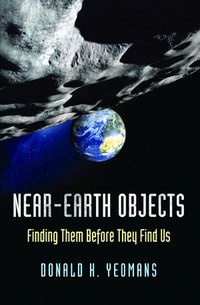Review: Near-Earth Objectsby Jeff Foust
|
| A typical rocky NEO one kilometer in diameter “contains more precious metals than have been mined on Earth in the entire course of human history,” Yeomans notes. |
Early on in the book, Yeomans addresses a simple but often overlooked question: why are there NEOs in the first place? That requires a detour into models of the development of the solar system, including the “Nice model” (named after the French city where it was developed, although Yeomans notes that it is a nice model) that explains the formation and early evolution of the solar system, particularly how the giant outer planets ended up in their current orbits. NEOs come largely from the inner main asteroid belt, where gravitational resonances with the outer planets, such as the 3:1 resonance with Jupiter at a distance of 2.5 astronomical units, pumps up the eccentricity of those asteroids’ orbits, sending them into the inner solar system. The typical lifetime of a NEO is only several million years, Yeoman notes, with several “sinks” removing them, including collisions with planets like the Earth.
NEOs are more than just a fusillade of cosmic bullets the Earth has to travel through. Yeomans devotes a chapter to the roles NEOs can plan as targets for exploration, including human missions as proposed by the Obama Administration in 2010, and as caches of resources: a typical rocky NEO one kilometer in diameter “contains more precious metals than have been mined on Earth in the entire course of human history,” he notes. Accessing those resources is a challenge, he acknowledges, and these resources may make more sense to support operations in space than to return resources to the Earth.
However, as the book’s subtitle—“ Finding Them Before They Find Us”—suggests, Yeomans devotes more attention to the threat NEOs pose to the Earth, and the need to search for these objects. That emphasis does make some sense, as it is the impact threat that’s driven most search efforts, including the goals to first detect 90 percent of NEOs one kilometers or larger and, more recently, those 140 meters across or larger (thresholds chosen since they represent the minimum sizes of objects capable of global and regional destruction, respectively, if they struck the Earth.) Yeomans, in the book’s final chapters, examines the damage an impacting NEOs can do, the work involved in predicting potential impacts, and even what could be done to deflect a threatening NEO.
Yeomans does a fine job consolidating all of these issues into a slender book (just over 150 pages, excluding references and the index) that’s accessible to anyone interested in the topic, yet informative enough that even those familiar with NEOs will likely pick up some new knowledge and insights. If there’s one flaw in the book, it’s that the lag in publication means some relatively recent developments are missing. In the chapter on the resource potential of asteroids, for example, there’s no mention of Planetary Resources, which announced their long-term plans to mine asteroids in April (see “Planetary Resources believes asteroid mining has come of age”, The Space Review, April 30, 2012). While Yeomans discusses how a space-based telescope in a Venus-like orbit could do a far more thorough job of cataloging NEOs than those on Earth, he doesn’t mention the B612 Foundation’s plans, unveiled in late June, to privately develop such a mission (see “A private effort to watch the skies”, The Space Review, July 2, 2012).
“Near-Earth objects are among the smallest members of the solar system,” Yeomans writes near the end of the book, “but their diminutive size is in no way proportional to their importance.” His book makes clear their importance, as both threats to life on Earth and as stepping stones for humanity’s expansion beyond Earth.
